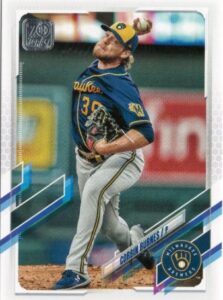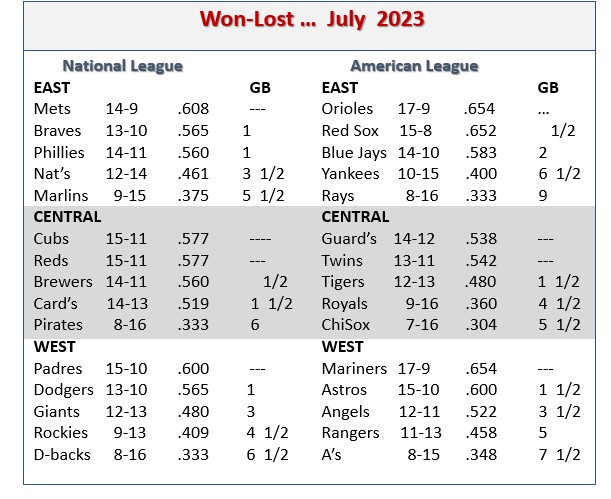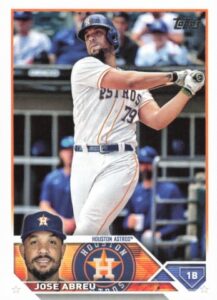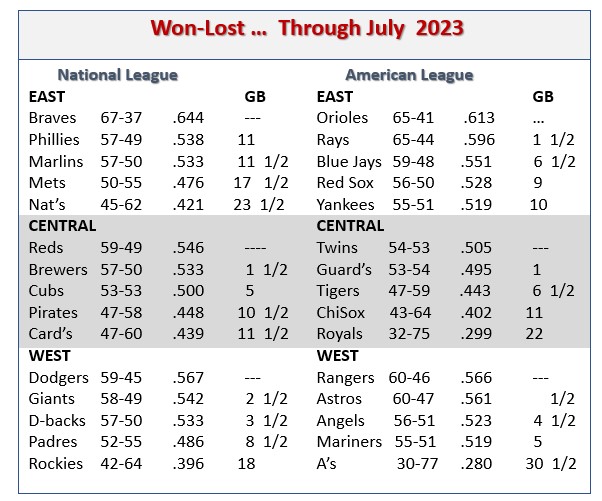This day (August 22) in 1982, Cardinal’s backup catcher Glenn Brummer produced an unexpected performance that still stands as a unique moment in Redbird lore. Let’s start this tale with a bit of a bit of background.
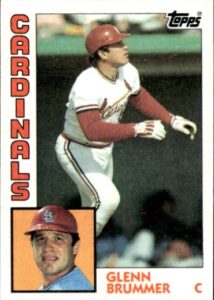 First, Brummer was not just the Cardinals’ backup catcher, he was the backup to the backup – with starter Darrell Porter and backup Gene Tenace ahead of him. He had, in fact, spent part of the early season as a backup catcher at Triple-A until an injury to Porter led to Brummer’s callup (when Porter recovered, the Cardinals kept Brummer on the team as a third-string backstop and defensive replacement).
First, Brummer was not just the Cardinals’ backup catcher, he was the backup to the backup – with starter Darrell Porter and backup Gene Tenace ahead of him. He had, in fact, spent part of the early season as a backup catcher at Triple-A until an injury to Porter led to Brummer’s callup (when Porter recovered, the Cardinals kept Brummer on the team as a third-string backstop and defensive replacement).
Second, Brummer did not start behind the plate that day. In fact, he didn’t enter the game (Giants at Cardinals) until the bottom of the eighth, when he came on as a pinch runner for pinch hitter Steve Braun (who had hit for Tenace) and stayed in at catcher. (Keep that pinch runner designation in mind, it will play later in this tale.)
Coming into the game, Brummer had one career stolen base (it had come on June 4 of that year) and he had notched just one plate appearance (in nine game appearances) since June 23 (when he delivered a single after coming in as a defensive replacement).
In that August 22 game, the Cardinals trailed 4-3 when Brummer entered, but tied it at four in the bottom of the ninth, which – ultimately – set up Brummer to deliver the unexpected (as a runner).
Brummer opened the bottom of the tenth with a strikeout (versus Gary Lavelle) and when his spot in the lineup came around in the twelfth inning, it was still 4-4 and Lavelle was still on the mound. Brummer delivered a one-out single, then moved to second on a single by CF Willie McGee. After a foul pop out by 3B Julio Gonzalez, an infield single by SS Ozzie Smith loaded the bases (Brummer on third) with two outs. Brummer noticed that Lavelle didn’t seem to be paying much attention to him. (Drummer after all had one career MLB stolen base at the time.) So, he worked to extend his lead. Then, with a 1-2 count on LF David Green, Brummer made a successful straight steal of home to win the game. (It was his second and final steal of the season.)
The play, by the way , was not without controversy. As Brummer broke for home, Giants’ catcher Milt May stepped in front of the plate to catch the pitch and attempt a tag on Brummer and umpire Dave Pallone stepped to the side to better see and make the call. The Giants argued that Pallone had not made a “call” on the pitch – which would have been out number-three and negated the run if it was a strike. The Cardinals argued that since the pitch never reached the plate, it could not be a strike (or even a pitch). Pallone then called the pitch ball to end the debate and the steal became part of Redbirds’’ lore.
Brummer, by the way, played in 178 games in five MLB seasons (1981-85) – during which he hit .251-1-27 in 347 at bats and stole just four bases in 12 tries (including one memorable swipe for a 12trh inning victory).
So, why is this story her today? Because, I’m pretty sure anyone would have given you odds of 1,00-to-one or better against Brummer swiping home (particularly with two outs and two strikes on the batter and the bases loaded) to win an extra-inning game. And I like that 1,000 number because this is the 1000th Baseball Roundtable post.
With that, I’m going to dedicate this post to some unexpected on-field occurrences or coincidences that I have particularly enjoyed coming across while researching the previous 999 offerings. These tidbits are presented in no particular order – like looking at a series of unrelated slides (remember slides) – but I hope readers find some of them interesting or entertaining.
I Call Your Steal of Home and Raise You One
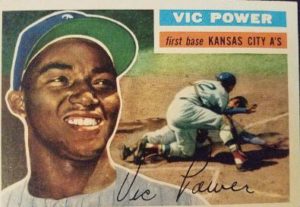 On August 14, 1958, the Indians’ Vic Power tied an MLB record by stealing home an MLB record-tying twice in one game – the second of which came in the bottom of the tenth inning, giving the Indians a “run-off” 10-9 win over the Tigers. Why does this feat find a place on my unexpected list? Power stole only three bases during the entire 1958 season.
On August 14, 1958, the Indians’ Vic Power tied an MLB record by stealing home an MLB record-tying twice in one game – the second of which came in the bottom of the tenth inning, giving the Indians a “run-off” 10-9 win over the Tigers. Why does this feat find a place on my unexpected list? Power stole only three bases during the entire 1958 season.
Do You Want Fries With That?
On Opening Day, April 7 – 2022, Diamondbacks’ DH Seth Beer hit his second MLB home run – a walk-off, three-run shot in the bottom of the ninth (as the Diamondbacks topped the Padres 4-2 in Arizona). Notably, Beer’s blast came on National Beer Day. About a month-and-a half later, on National Hamburger Day (May 28), White Sox’ 3B Jake Burger hit his fifth career home run (as the White Sox lost to the Cubs 3-1 at Guaranteed Rate Field). Hmmm. When is the next National French Fry Day?
An Oddly Even Game
On August 13, 1910, the Pittsburgh Pirates and Brooklyn Superbas (Dodgers) played perhaps the most “even” MLB game ever. The first game of that day’s twin bill was pretty tight – a 13-inning,3-2 Pirates’ win. Game Two put Game One to shame. It ended after nine frames in an 8-8 tie (called due darkness). In the game:
- Each team scored 8 runs;
- Each team recorded 13 hits in 38 at bats;
- Each team made two errors;
- Each team recorded 13 assists and 27 putouts;
- Each team gave up three walks;
- Each team suffered one hit batsman;
- Each team fanned five times;
- Each team was charged with one passed ball;
- Each team was awarded five RBI among their eight runs scored.
Another Oddly Even Game
On April 15, 1968, The Astros topped the Mets 1-0 in 24 innings. In that one:
- Each team had 11 hits in 79 at bats;
- Each team had ten singles and one double;
- Each team left 16 men on base;
- Each squad made on error;
- Each team threw two wild pitches;
- Each team turned one double play.
- Each team used four pinch hitters.
Oh, and by the way, the wining tally scored on a groundball error. So, each team scored zero “earned” runs.
Won’t See This Again. Probably Wasn’t Expected Even Then.
On May 1, 1920 The Brooklyn Robins and Boston Braves played the longest game (in innings) in MLB history – a 26-inning 1-1 tie. The unexpected? Both starting pitchers (Brooklyn’s Leon Cadore) and Boston’s Joe Oeschger) went the distance.
Probably Won’t See This Either
From 1950-59, The Phillies’ Robin Roberts averaged just over 300 innings pitched per season (3011 2/3 innings pitched in ten seasons). Further, in a six-year span (1950-55), he averaged 323 innings pitched per season and led the NL in innings logged five times – never throwing less than 304 1/3 innings in a season.
Timing is Everything
Sammy Sosa is the only player to hit 60 or more home runs in three seasons 1998, 1999 and 2001 – and he didn’t lead his league in home runs in any of those campaigns. In 1998, as a Cub, he finished with 66 home runs to the Cardinals’ Mark McGwire’s 70. In In 1999, it was Sosa with 63 homers and McGwire with 65. In 2001,Sosa had 64 homers to the Giants’ Barry Bonds 73.
More timing – Shortest Solo Reign as MLB Home Run King
On September 25, 1998 Sammy Sosa hit his 66th homer of the season off Jose Lima – taking sole possession of the all-time lead for home runs in an MLB season. Just 45 minutes later, Mark McGwire tied Sosa for the lead with his 66th homer of the season and the very next day McGwire took sole possession of the record with his 67th.
As ESPN Classic reports, at 8:39 p.m. (CDT) Sosa hit his 66th longball of the1998 season (fourth inning off Astros Jose Lima) – moving one ahead of McGwire as the all-time single-season record holder. At 9:24 p.m. that same night, McGwire moved back into a tie with a home run off Nationals’ Shayne Bennett. (McGwire eventually hit 70 that season, a record that stood until 2001, when Barry Bonds hit 71.) Note: Babe Ruth held the single-season home run crown from September 28 1919 until October 1, 1961 (breaking his own record several times that span).
An Unexpectedly Tense Game
On September 9, 1965 future Hall of Famer Sandy Koufax pitched a perfect game against the Cubs (in LA). Unexpectedly, he pretty much needed to be that good. His mound opponent that day was Bob Hendley (who would go on to a 48-52, 3.97 record in seven MLB seasons). Hendley gave up just one hit and one walk in the game – surrendering just one unearned run. Thus Hendley, perhaps unexpectedly, shares the record with Koufax for the fewest (combined) hits ever allowed in an MLB game (one).
Some Milestone Homers
- Brothers B.J. and Justin Upton both hit their 100th career home runs on the same day – August 3, 2012.
- On April 13, 2009. White Sox RF Jermaine Dye and 1B Paul Konerko each hit their 300th career home runs – and they did it back-to-back in the top of the second inning.
Stan and Nate – The Grandaddy of All MLB Coincidences
This story has been told often, but it remains The Roundtable’s favorite baseball coincidence. On May 2, 1954, Stan “The Man” Musial had one of the greatest days at the plate in major-league history. That day, the New York Giants faced Musial’s Cardinals in a double header before 26,662 fans at Busch Stadium (I). Game One, a 10-6 Cardinal win, saw Musial go four-for-four with three home runs (his first-ever three-homer game) and six RBI. In Game Two, a 9-7 Cardinals’ loss, Musial went two-for-four, with two home runs and three RBI – becoming the first player ever to hit five home runs in a doubleheader.
Among the 26,662 fans witnessing Musial’s feat was eight-year-old Nate Colbert – who, on August 1, 1972, would become the second player in MLB history (and there are still only two) to hit five round trippers in a double header. In Game One of that doubleheader (Padres at Braves), Colbert went four-for-five, with two home runs and five RBI, as the Padres won 9-0. In Game Two, an 11-7 Padres’ win, Colbert went three-for-four with three home runs and eight RBI. Stan Musial, however, was not in the crowd. (Now, that would really have been a coincidence.)
A Royal Coincidence?
The Kansas City Royals were the first AL expansion team to win a Division Title; a League Championship; and a World Series Crown – and they did it in three different seasons – 1976, 1980 and 1985, respectively.
Like Father, Like Son
Cecil (father) and Prince (son) Fielder were both big-league power hitters. Cecil enjoyed a 13-season MLB career, while Prince played in 12 MLB season. Cecil’s career stat line was .255-319-1,008, while Prince was .283-319-1,028. The key coincidence for me here is that home run number.
Father and son:
- Each hit 319 carer homers;
- Each had one season of 50 or more homers;
- Each had one season of 40-49 homers;
- Each had four seasons of 30-39 home runs.
And, they were “closers:”
- Each hit 97 home runs with two outs;
- Each hit 18 ninth-inning long balls.
Are You Sure about That?
The winning pitcher in the first and only MLB Hispanic American All-star game was Alvin O’Neal McBean. Click here for the full story on that one.
Consistently Is Not always A Hobgoblin
In 1996, the Rockies’ Vinny Castilla’s’ stat line was .304-40-113. In 1997? .304-40-113.
Statistics Can Be Fun
Placido Polanco is the all-time leader (Minimum 500 games) in fielding percentage at third base and second base.
A Good Day To Be Born
In 1994, White Sox’ 1B Frank Thomas was the American League MVP and Astros’ 1B Jeff Bagwell was the National League MVP – both were born on May 27, 1968.
By George, That’s a Good one
Hall of Famers Tom Seaver, Sparky Anderson, Ken Griffey, Jr., Babe Ruth and Rube Waddell are all “Georges.” George Thomas Seaver; George Lee Anderson; George Kenneth, Griffey, Jr.; George Herman Ruth; and George Edward Waddell.
That’s Your Uncle Bob
Bob Lemon, who made the Hall of Fame as pitcher, played CF when the Indians’ Bob Feller no-hit the Yankees (1-0) – marking the first time the Yankees were no hit at Yankee Stadium. (Lemon started his career as a 3B-OF. ) Makes a good trivia question: What Hall of Famer played CF in Bob Feller’s second career no-hitter?
That was Fun, Let’s Do It Again.
On May 2, 2002 2B Brett Boone and CF Mike Cameron were batting in the two and three holes in the Mariners’ lineup, as they faced off against the White Sox in Chicago. After Mariners’ RF Ichiro Suzuki was hit by a pitch (on the first pitch) to open the game, Boone took the very next pitch from White Sox starter Jon Rauch to deep RF for a two-run home run. It took four pitches, but Cameron followed up with a solo home run – a couple of back-to-back blasts. Six runs and two outs later, Boone came up again and delivered another two-run home run (this time off Jim Parque) and Cameron followed with a solo shot to center. Back-to-back twice in the same inning – an unexpected MLB first and still only. Cameron, by the way, went on to hit an MLB single-game, record- tying four home runs in the contest – won by the Mariners 15-4.
Let Me Show You How its Done

Photo by gomarky 
On June 18, 1999, the Yankees’ David Cone pitched a perfect game, as New York downed Montreal 6-0 at Yankee Stadium. It came on Yogi Berra Day and the ceremonial first pitch was thrown by Don Larsen – who pitched a Perfect Game in the 1956 World Series – to Berra.
Perfectly Unexpected
The White Sox’ Phil Humber pitched eight seasons in the big leagues – going 16-23, with a 5.31 earned run average. He made 51 starts and tossed just one career complete game. It as a good one though – a perfect game against the Mariners (in Seattle). Humber completed the masterpiece in 96 pitches (67 strikes) with nine strikeouts. In the game, Humber did not go to a three-ball count on any batter until the ninth (two 3-2 counts) and only seven balls were hit out of the infield.
I Like The Pressure
Twenty-year-old righty Francisco Rodriguez made his MLB (with the Angels) on September 18, 2002. He pitched in just five games – 5 2/3 innings, three hits, two walks, 13 whiffs – but he made it the post-season roster. In the 2002 post-season he pitched in 11 games, 18 2/3 innings, giving up ten hits and two runs, while walking five and fanning 28. More importantly, he had five post-season wins – all before he recorded a regular-season decision (win or save). He went on to pitch in 16 MLB seasons, going 52-53, 2,86, with 437 saves (leading the league three times) with 1,142 strikeouts in 976 innings.
On A Last Place Team. Kind Of Unexpected, But It Was Lefty.
On (August 21, 1972, Phillies’ lefty Steve Carlton, on his way to his first Cy Young Award, lost a heartbreaker to the Braves (2-1 in 11 innings) in Philadelphia. Carlton went all 11 innings (two runs, seven hits, three walks, ten whiffs, as did his mound opponent Phil Niekro (one run, nine hits, three walks, ten strikeouts.) So, why does a Carlton loss appear in this post?
Because it broke a string of 15 consecutive winning decisions (with four no-decisions tossed in) since his last loss (which came on May 30). In those 19 starts. Carlson had gone 15-0 and the Phillies had gone 17-2. What attracted The Roundtable’s attention was that during that same time period between Carlton losses (June 1 – August 21), the Phillies had gone 27-47 … 17-2 in games Carlton started and 10-45 in those he didn’t. For the season, Carlton went 27-10, 1.97 and the Phillies went 29-12 in Carlton’s starts and 30-85 when he didn’t take the mound. Carlton, while pitching for the last-place Phillies led the NL in wins (27), ERA (1.97), starts (41), complete games (30); innings pitched (346 1/3); and strikeout 310. It earned him the Cy Young Award.
Getting A Late Start On A Strikeouts Lead
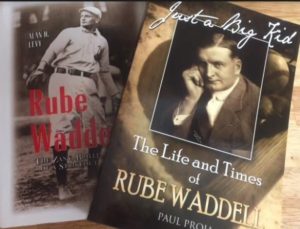 Had there been a Cy Young Award in 1902, Rube Waddell – like Steve Carlton above, would have won it. And, his accomplishment would have been as unlikely as a pitcher on a last place club capturing that honor. Waddell started the 1902 season in the California League and didn’t make his first MLB start of the season until June 26 – for the fourth place Philadelphia Athletics (who were just one game over .500 at 26-25).
Had there been a Cy Young Award in 1902, Rube Waddell – like Steve Carlton above, would have won it. And, his accomplishment would have been as unlikely as a pitcher on a last place club capturing that honor. Waddell started the 1902 season in the California League and didn’t make his first MLB start of the season until June 26 – for the fourth place Philadelphia Athletics (who were just one game over .500 at 26-25).
Despite missing more than 40 percent of the MLB season, Waddell went on to lead the league in strikeouts (210) and finish second in wins (24 versus seven losses); while putting up the league’s second-best ERA at 2.05. Oh, and he led the Athletics to the AL pennant. For more on the amazing and zany career of Waddell, click here.
Don’t Worry Boys, I’ll Handle This
In 1920, Babe Ruth, hit 54 home runs for the Yankees Not a surprise – unless, of course, you factor in the fact that no other American League team hit more than 50 and Ruth also outhomered all but one of the National teams (the Phillies had 64 team homers.) The second-most home runs by any player in 1920 was the Browns’ George Sisler’s 19.
Ray Caldwell Hit By Lightning – Finishes Game
 On August 24, 1919 hard-nosed righty Ray Caldwell made his first appearance on the mound for the Cleveland Indians (he had been released the Red Sox) – and it was electrifying (even death-defying) . He started against the Philadelphia Athletics – under threatening skies. He got to the bottom of the ninth with a 2-1 lead. With two outs and the A’s number-five hitter Joe Dugan at the plate, the skies delivered on their threat. As witnesses reported, a lightning bolt blazed from the sky, hit near the press box, traveled down the ballpark railing, exited and crossed the field, dropping Caldwell (some said it hit him in the top of the cap). Caldwell was on the ground for about five minutes, then slowly sat up, got to his feet, shook his head to clear the cobwebs (or perhaps th eclectic buzz), demanded the ball and promptly retired Dugan on a ground out to third. For the full story on Caldwell unexpected finish to this game, click here.
On August 24, 1919 hard-nosed righty Ray Caldwell made his first appearance on the mound for the Cleveland Indians (he had been released the Red Sox) – and it was electrifying (even death-defying) . He started against the Philadelphia Athletics – under threatening skies. He got to the bottom of the ninth with a 2-1 lead. With two outs and the A’s number-five hitter Joe Dugan at the plate, the skies delivered on their threat. As witnesses reported, a lightning bolt blazed from the sky, hit near the press box, traveled down the ballpark railing, exited and crossed the field, dropping Caldwell (some said it hit him in the top of the cap). Caldwell was on the ground for about five minutes, then slowly sat up, got to his feet, shook his head to clear the cobwebs (or perhaps th eclectic buzz), demanded the ball and promptly retired Dugan on a ground out to third. For the full story on Caldwell unexpected finish to this game, click here.
Gotta Love them Zeroes
In 1968, Dodgers’ righty Don Drysdale pitched a record six consecutive complete-game shutouts between May 14 and June 4. In those 54 innings, he gave up just 27 hits and nine walks, while fanning 42. Surprisingly, the Big D finished the season at just 14-12 (but with a 2.15 ERA), despite the six straight whitewashings. In all, eight of his 14 wins were shutouts.
Who Says Pitchers Can’t Hit?
The first National Leaguer (any position) to hit two Grand Slams in a game was a pitcher – Tony Cloninger, who did it in a Braves 17-3 win over the Giants on July 3, 1966. Cloninger collected a pitchers’ record nine RBI in the game – and also threw a complete-game seven-hitter. This tidbit gets “extra credit” when you add the fact that, after retiring from MLB, Cloninger became a world-class slow-pitch softball player. In 1978 (six years after his MLB retirement), playing for the United States Slow-Pitch Softball Association’s Slow-Pitch World Series Champion Howard & Carroll team, Cloninger was selected as the third baseman on the Series All-World Team.
Got Any More Bob millers Out in the Pen?
On August 15, 1962, as the Philllies topped the Mets 9-3 in the first game of a twin bill, Phillies’ starting left fielder Don Demeter touched up starting pitcher right-hander Bob Miller (Robert Lane Miller) for a third-inning, solo home run. In the ninth frame, Demeter (who had now moved to CF) hit a three-run home run, this time off left-handed reliever Bob Miller (Robert Gerald Miller). So, two home runs in one game off two Bob Millers, one southpaw and one righty, one starter and one reliever, while in the lineup at two different positions.
The Jim and Chuck Show
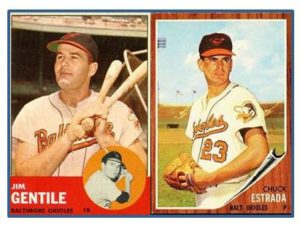 In 1961, the Orioles’ Jim Gentile tied the MLB record and set a new AL mark (both since broken) for Grand Slams in a season with five bases-loaded long balls. Every one of Gentile’s five four-run blasts was hit in a game started by Orioles’ righty Chuck Estrada (who, as you would expect, picked up a victory in all four contests). Added credit for the fact that Gentile hit only one other Grand Slam in his career (June 26, 1960) and – you guessed it – the starting and winning pitcher in that contest was Chuck Estrada.
In 1961, the Orioles’ Jim Gentile tied the MLB record and set a new AL mark (both since broken) for Grand Slams in a season with five bases-loaded long balls. Every one of Gentile’s five four-run blasts was hit in a game started by Orioles’ righty Chuck Estrada (who, as you would expect, picked up a victory in all four contests). Added credit for the fact that Gentile hit only one other Grand Slam in his career (June 26, 1960) and – you guessed it – the starting and winning pitcher in that contest was Chuck Estrada.
More Grand Slam Surprises
In 1987, Yankees’ first baseman Don Mattingly set an MLB single-season record (since tied) with six Grand Slams. Despite a 14-season career that included 163 bases-loaded plate appearances, Mattingly did not hit another Grand Slam before or after those record-setting six.
Wha-a-at?
Babe Ruth had more inside-the-park home runs and more steals of home than Ricky Henderson.
A Couple Of Bookends
John Miller hit just two home runs in his MLB career – one for the Yankees in 1966 and one for the Dodgers in 1969. Those blasts made him one of just two MLB players to homer in their first and last MLB plate appearance.
This Seems Unlikely, I Guess.
Only five times in MLB history has a pitcher fanned 20 batters in nine innings – Roger Clemens (twice); Kerry Woods; Max Scherzer; and Randy Johnson. (Johnson was the only non-complete game. He fanned twenty in nine innings, but was relieved by Byung-Hyun Kim in the top of the tenth with the score tied 1-1.) The tidbit that attracted me here is that is that in those five nine-inning, 20-strikeout outings, these dominating pitchers did not walk a single batter. That’s right, 100 whiffs and not a single walk.
Side Note; Om September 12 1962, Tom Cheney of the Washington Senators set the MLB record for strikeouts in a single game at 21. Cheney pitched a 16 -inning complete game, one run on ten hits and four walks, with 21 strikeouts – as the Senators won 2-1.
It’s Good To Have Backup
In 1961, when Roger Maris hit 61 homers to break Babe Ruth’s homerun record, he drew zero intentional walks. (He was batting in front of Mickey Mantle.)
Casey Got A Good Start at Yankee Stadium
Casey Stengel, while a member of the New York Giants, hit the first-ever inside-the-park and over-the-fence post-season home runs in Yankee Stadium, (Games One and Three of the 1923 World Series.)
Just Start Me In Twin Bills
In August of 1903, the Giants’ Joe McGinnity started both games of a double header three times (August 1, 8 and 31), pitched six complete games and won them all, giving up just ten runs. What puts this on this list is, that same month, McGinnity pitched just one game on six other occasions – going 1-5 and giving up 28 runs. Apparently, he liked a full day’s work.
Primary Resources: Baseball-References.com; Baseball-Almanac.com; MLB.com; ESPN.com
_________________________________________________
About Baseball Roundtable: Over the span of 1,000 posts, Baseball Roundtable has published a combination stats and stories, observation and opinion (mine and the readers’). On these pages, The Roundtable has launched:
The Annual John Paciorek Award – honoring players with brief, but in some way notable, baseball careers. For the latest JPA post – with a link to all the JPA offerings, click here.
The “Who’s Your Daddy?” Series – presenting position-by-position lineups of players who performed exceptionally well against some of the best pitchers of all time. For the latest “Who’s You Daddy?” post, which includes links to the entire series, click here.
The Baseball Roundtable Trot Index – tracking the percentage of plate appearances that result in a “trot” – around the bases (home run); back to the dugout (strikeout); or to first base (walk, hit by pitch, catcher’s interference.)
The annual Baseball Roundtable Unofficial Fan Hall of Famed Ballot, as well as fan surveys on the baseball experiences (time of game, concessions, etc.), proposed rule changes and the general state of the game.
Lists covering topics from Baseball Roundtables’ favorite baseball quotes, nicknames and baseball cards.
Baseball Roundtable has also offered month-by-month MLB season summaries – with stats, stories (highlights) and Baseball Roundtable’s Players, Pitchers and Surprise of the Month. Baseball Roundtable has also featured guest posts by former players; coaches; sportswriters; writers from such websites as LiftYourGame.net, CatcherHome.com; The BaseballReviews.com; OldSportCards.com; I70Baseball.com; and even an Emmy Award Winner.
Looking forward to the next 1,000 posts. Thanks to all for reading The Roundtable.
Baseball Roundtable – Blogging Baseball Since 2012.

 Baseball Roundtable is on the Feedspot list of the Top 100 Baseball Blogs. To see the full list, click here.
Baseball Roundtable is on the Feedspot list of the Top 100 Baseball Blogs. To see the full list, click here.
Baseball Roundtable is also on the Anytime Baseball Supply Top 66 Baseball Sites list. For the full list, click here.
I tweet (on X) baseball @DavidBaseballRT
Follow/Like Baseball Roundtable’s Facebook Page here. Find More baseball commentary; blog post notifications; PRIZES.
Member: Society for American Baseball Research (SABR); Negro Leagues Baseball Museum; The Baseball Reliquary.

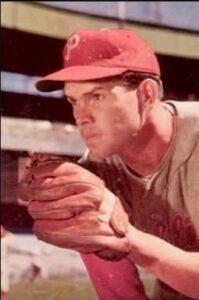
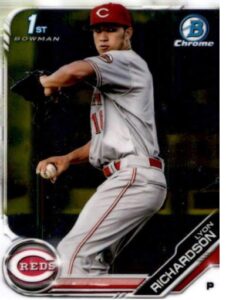



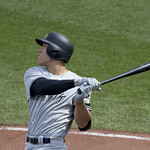


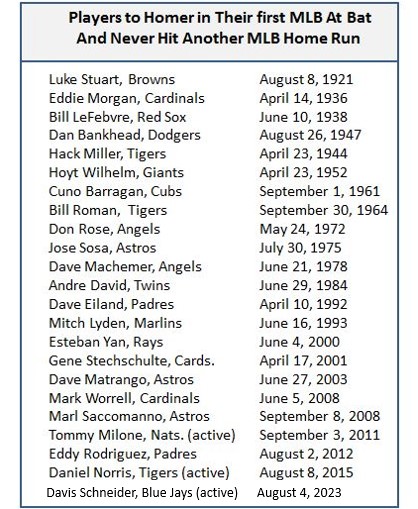
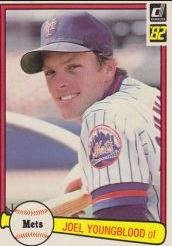
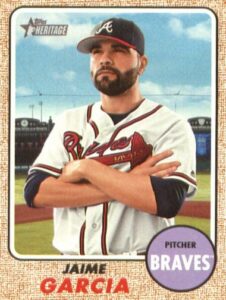

 And, finally, Joel Youngblood does not stand alone in playing for two teams in a single day. On May 30, 1922, the Cubs and Cardinals made a trade that made MLB history. The two squads were facing off (in Chicago) in a Memorial Day doubleheader. Remember those?
And, finally, Joel Youngblood does not stand alone in playing for two teams in a single day. On May 30, 1922, the Cubs and Cardinals made a trade that made MLB history. The two squads were facing off (in Chicago) in a Memorial Day doubleheader. Remember those?

